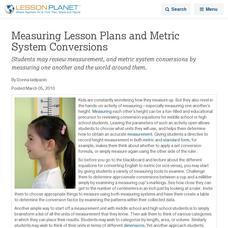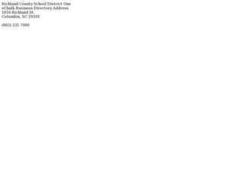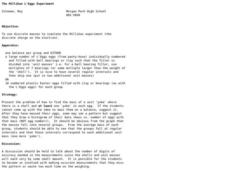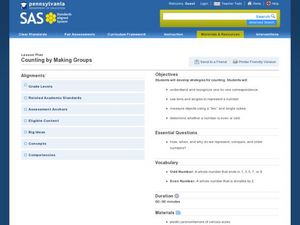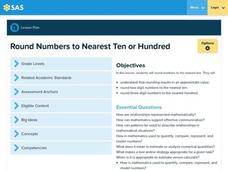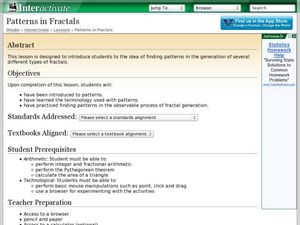Curated OER
Investigation - Square Numbers and Triangle Numbers
Fifth graders investigate growth patterns using blocks. In this square and triangle numbers lesson, 5th graders predict sizes of larger triangles and squares based on numerical patterns they observed while building.
Curated OER
Polygons: Angles vs. Sides
Young scholars analyze the relationship between the number of sides of a polygon and the sum of its angles. Pattern blocks are utilized to trace the outside of the shapes. They make their own outline of a four-sided polygon from the...
Curated OER
Creating Rose Windows
Learners view a multimedia presentation to recognize rose windows and quilting patterns. In this rose window perimeter lesson, students design rose window from paper. Learners review prior knowledge of lines and how they create shapes.
Curated OER
Divisibility Rules Using Scientific Calculators
Young learners apply divisibility rules to determine if a number is a factor of another number. They discuss what numbers are factors of another number and identify patterns using divisibility rules.
Curated OER
Warm Up to Weaving With the Right Lesson Plans
Explore the process of creating the fabrics, cloths, blankets, and rugs that warm the chilly months of winter with weaving lesson plans.
Curated OER
Measuring Lesson Plans and Metric System Conversions
Students may review measurement, and metric system conversions by measuring one another and the world around them.
Alabama Learning Exchange
Musical Patterns
Young scholars explore the concept of patterning using musical instruments. In this music activity, students identify several instruments and practice playing patterns with them. Young scholars identify the patterning in a musical piece.
Curated OER
Patterns In Hexagon Tables
Sixth graders construct a rule about the number of sides found in a pattern of hexagons. In this mathematical problem solving lesson, 6th graders observe different hexagon patterns and create a rule about the relationship between the...
Curated OER
Perplexing Patterns
Seventh graders identify and find missing patterns. In this algebra instructional activity, 7th graders investigate numbers and sequences and complete the pattern. They make a chart and discuss similarities and differences.
Curated OER
The Millikan L'Eggs Experiment
Students discover a pattern to mysterious eggs made by their teacher. In this mass lesson, students must uncover a secret pattern given plastic eggs and a balance. Students find the eggs have been created with a pattern and draw them...
Curated OER
The Legend of the Poinsettia
Young scholars explore the poinsettia and its symbolism as a Christmas flower. Students will listen to a story about the poinsettia and its origins in Mexico and discuss what they know about Mexico. They will discuss the poinsettia's...
Curated OER
Harry the Dirty Dog
Students investigate the parts of a book by reading a story about a dog. In this reading comprehension instructional activity, students utilize their memory to place pictures from the book Harry the Dirty Dog in order from start to...
Curated OER
Learning Multiples of Three
Third graders practice counting and multiplying by three. In this multiplication lesson plan, 3rd graders review the pattern of multiples of two and are shown the additive property of 3's. Students practice using a number chart to...
Curated OER
Counting by Making Groups
First graders represent, compare, and order numbers. In this counting skills lesson, 1st graders use manipulatives to demonstrate one-to-one correspondence and to represent numbers. This lesson includes a teacher script to guide the lesson.
Pennsylvania Department of Education
Round Numbers to Nearest Ten or Hundred
Third graders review telling time. In this lesson on telling time, 3rd graders discuss various items that show length of time, including clocks, calendars and sand timers. Students review and practice what they already know about telling...
Curated OER
Gee's Bend Quilts Three
Third graders identify and practice sewing a dashed line in an arch shape. They identify with five new facts about quilts, women, and the community of Gee's Bend. Finally, 3rd graders complete the quilt top, batting and backing together.
Curated OER
Patterns In Fractals
Students find number patterns in the generation of several different types of fractals.
Curated OER
Patterns in Fractals
Students explore the concept of fractal patterns. In this fractal pattern lesson plan, students use an applet about the Hilbert Curve to answer questions about rectangles and other polygons. Students derive the fractal pattern when...
Curated OER
Terrific Tessellations
Students construct tesselations that fosters their ability to create, transform, and critique their own piece of work. This allows them to become aware of repeated patterns in math, and connect these patterns to artwork.
Curated OER
Tiling the Classroom
Students see how to identify regular polygons, how to slide, turn and flip polygons, and why certain polygons tessellate better than others. Groups create a one foot square design to be used to tile the classroom. Great instructional...
Pennsylvania Department of Education
What is the Chance?
Fourth and fifth graders make predictions using data. In this analyzing data lesson, pupils use experimental data, frequency tables, and line plots to look for patterns in the data in order to determine chance. You will need to make a...
Curated OER
Decreasing and Increasing Fractions
Use this math lesson to help your fourth graders further their understanding of ordering fractions. After completing some whole-group activities together as a class, pairs of students play an online game which has them compare fractional...
EngageNY
The Structure of Ratio Tables—Additive and Multiplicative
Build tables by understanding their structure. Scholars take a closer look at the structure of ratio tables in the 10th segment in a 29-part series. Individuals realize that the tables can be built using an additive or multiplicative...
Concord Consortium
Last Digit Arithmetic
Mathematics involves a study of patterns. The exploratory lesson has learners consider the addition pattern in different sets of numbers. Each set has a different pattern that pupils describe mathematically. The patterns involve both...







